A lawn mower is a hefty investment, so it’s very important to do your research to see what will best fit your lawn before spending any money. There are two basic types of lawn mower: ride-on tractors and push mowers. And each category has multiple sub-types like zero-turn, AI-driven robot, or self-propelled. It’s also important to note how each lawn mower you’re considering gets its power.
The vast majority of models use gas-powered engines, which means that you have to consider the cost of keeping extra fuel and performing regular maintenance into your budget. There are also battery-powered electric models, both ride-on tractors and push mowers, that often use the same types of batteries you may already have for your cordless power tools; which makes it easier to integrate the mower into your arsenal and a bit more affordable to maintain since you don’t have to invest in specialized chargers or batteries. The downside to electric mowers is that they don’t have the same run-time as their gas-powered counterparts, with most having a maximum mow time of about an hour. Though this should be plenty of time to take care of most suburban lawns.
Robotic mowers are a recent innovation, working the same way as robotic vacuums and mops: working with AI and a home charging base to frequently mow different parts of your lawn for a consistently well-manicured yard. Their biggest drawbacks are both their hefty costs and the need to lay boundaries or guide wires to keep them in your yard and out of the street. Zero-turn mowers are similar to what you’d see in a commercial setting, featuring very large cutting decks and pivot-point turning for much better maneuverability around obstacles like trees, lamp posts, flower beds, and mailboxes.
To help you find the perfect lawn mower for your needs, I’ve chosen five of the best you can buy. I’ve broken down their major features, deck widths, and power sources to help you find the mower of your dreams, as well as the best fit for your budget.
Also: The 5 best electric lawn mowers: Top alternatives to gas-powered
Husqvarna YTH18542
Best lawn mower overall
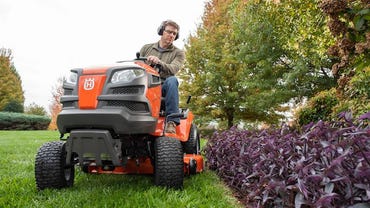
Personally, I have an older version of this lawn mower, and I can’t say enough good things about it. The stamped-steel, 42-inch cutting deck and 16-inch turn radius are perfect for yards up to an acre and for mowing around obstacles like trees, lamp posts, and fire hydrants. It features a hydrostatic drive, which means that the harder you push the pedal, the faster you go; no more needing to stop and manually adjust speed. You can even safely mow in reverse with the flip of a switch, which is perfect for tricky areas or for going back over spots you may have missed. The deck features a hose hookup for washing out the blades and discharge chute, which helps eliminate the build-up of dried grass and extends the life of your mower and blades.
An adjustable, 13-inch seat makes it easy to find a comfortable position to safely drive your mower, and an emergency shutoff switch automatically kills the engine if it doesn’t detect you in the seat; you can override this by setting the parking brake so you can move small obstacles like fallen branches, toys, or garden tools without needing to restart the engine. A 3-year bumper-to-bumper warranty covers the mower, so you can quickly and easily get replacement belts, blades, and other parts if they become damaged during normal operation.
Pros:
- Good for lawns up to 1 acre
- 3-year warranty
- Reverse mow feature
- Auto shut-off safety switch
Cons:
- The seat is a bit tricky to adjust
- It needs regular maintenance for peak performance
Honda HRN 166cc
Best push mower
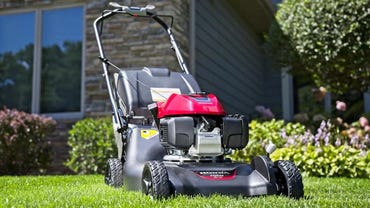
The Honda HRN, 166cc engine model, is the best push mower you can get. It features dual cutting blades in a 21-inch, stamped steel deck, which can be individually adjusted with separate levers for the perfect cutting height for almost any season and terrain. It includes a bagger attachment to collect clippings, though you can use the mulching feature to re-feed your lawn if you want. The rear wheels work with the drive train to propel the mower forward, and you can control the speed with the intuitive clutch attached to the handle; simply hold the throttle down and move the sliding button to set the perfect walking speed. A 3-year warranty covers the mower for replacing parts that become worn out or damaged during normal use, so you can rest assured your new Honda push mower will last season after season.
Pros:
- Adjustable speed
- Dual cutting blades
- Self-propelled
- Bagger included
Cons:
- Heavy (81lbs)
- Doesn’t fold up for storage
Ego Power+ electric push mower
Best electric lawn mower
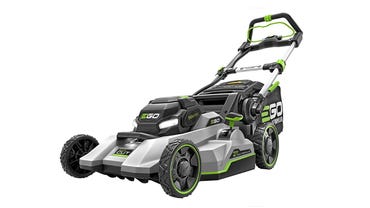
This model snagged the top spot in our list of the best electric lawn mowers you can buy, and for very good reason. You can get between 45 and 60 minutes of run time on a full charge, depending on your yard’s grade and terrain, which makes it perfect for smaller suburban lots. It also includes a bagger attachment for collecting grass clippings as well as a mulching feature to re-feed your lawn in between professional treatments. It’s self-propelled, with an adjustable throttle to match your walking speed, and you can easily adjust the cutting deck to 6 different heights with the side lever. Dual LED headlamps make it easy to see where you’re mowing in the early morning or late evening, and a push-button start eliminates frustrating ripcords for faster motor turnover so you can spend more time actually mowing your lawn and less time icing your sore shoulder from yanking on a cable. The entire mower also has a foldable design for more compact storage when not in use, which is perfect for garages and tool sheds that are on the smaller side.
Pros:
- Push-button start
- Folding design
- Self-propelled
- Up to 60 minutes of run time
Cons:
- Plastic construction may not hold up in rough terrain
- Not suited for yards over .5 acres.
Cub Cadet Ultima ZT1
Best zero turn mower
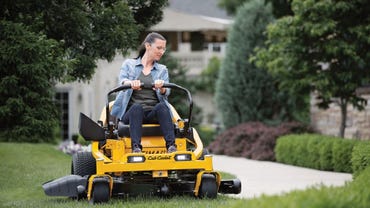
Zero-turn lawn mowers are great for anyone who has a lot of obstacles in their yard: trees, oddly-shaped garden beds, patios, etc. They’re called “zero-turn” because they have a turning radius of zero inches: either the right or left-back tire becomes a pivot point for the entire mower. This enables you to get exceptionally tight turns when navigating around smaller trees, decks and patios, or lamp posts. And the absolute best one you can buy is the Cub Cadet Ultima ZT1.
It has a 50-inch, triple-blade cutting deck that’s made of stamped steel, which makes it perfect for yards 2 acres and larger. It comes equipped with a standard side discharge chute, though you can buy a bagger unit or mulching kit for easier clipping collection or to re-feed your lawn. You can even buy a haul-behind wagon or snow plow attachment for year-round use, hauling bagged leaves or clearing snow from your driveway.
You control the mower via dual levers, which feels very different than the traditional steering wheel controls you find on most mowers, so I recommend practicing maneuvering around your yard with the cutting deck disengaged before using it to actually mow. The frame of the mower is made of 2 x 2-inch steel tubing for strength and durability in almost any condition, and a 3-year warranty covers the mower. The frame and deck have a lifetime warranty, so if there are any weld point failures, cracks in the deck, or issues with the blade spindles, they’ll be covered by Cub Cadet for as long as you own the mower.
Pros:
- Excellent warranty
- 50-inch deck
- 0-inch turn radius
- Perfect for large yards or yards with lots of obstacles
Cons:
- Expensive
- Drive levers have a steep learning curve
Worx Landroid L
Best robotic mower
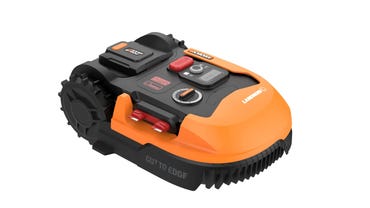
Robot lawn mowers are a recent innovation in lawn care. They’re similar to robot vacuums and mops, using Bluetooth and GPS technology to give you control over run-routines and to map your yard for more efficient mowing. The Worx Landroid L is one of the best and most affordable robot mowers on the market. It can handle lots up to half an acre, and unlike some other models, you don’t have to lay a guidewire for mowing patterns, though you do have to lay out a boundary wire to keep it from wandering into the street or your neighbor’s flower bed.
Once you’ve downloaded and set up the companion app, you can use a Bluetooth connection to set up mowing routines, lawn boundaries and mowing patterns, and check to see where the unit is in your yard in case it gets hung up on a tree root or stuck under a shrub. The app also alerts you if the mower has been removed from its designated areas so you can immediately report a theft and track its location via LTE cellular data for recovery.
For power, it uses the same 20, 40, or 80V rechargeable battery as other Worx-branded power tools, so it’s easier to integrate into your workshop, and you don’t have to worry about buying special charging equipment. It comes with a dedicated charging base, and the Landroid L automatically returns to it when the battery reaches a certain percentage, so you never have to go retrieve a dead mower from the back of your lot and carry it back to the charging station. Worx doesn’t specify a maximum run time on a full charge, but they reassure you that the Landroid L will mow frequently in order to maintain an evenly-trimmed lawn; I would expect an hour run-time, tops, if your lawn doesn’t have any rough spots, steep inclines, or obstacles.
The Landroid L is rated for lawns up to .5 acres, featuring an 8-inch cutting disc mounted on a floating arm so that it can follow the contours of your lawn without scalping high points or missing dips. The rear wheels feature protrusions to help it grip the ground without destroying your lawn while a single front pivot wheel gives it exceptional maneuverability.
Pros:
- Bluetooth, Wi-Fi, and LTE connectivity
- Auto-run and auto-charge feature
- Floating cutting deck
- Rated for up to .5 acre
Cons:
- Expensive
- Requires boundary wire installation before first use
- Mows in random patterns instead of straight lines
What is the best lawn mower?
The Husqvarna YTH18542 is the best lawn mower you can get. It has a mow-in-reverse feature that’s perfect for navigating tricky areas or going back over spots you may have missed, as well as a 42-inch, dual-blade deck that’s great for lawns up to 1 acre. The 16-inch turn radius makes it easier to maneuver around trees, lamp posts, decorations, and mailboxes, and the deck can be outfitted with either a bagger or mulching attachment for easier cleanup and lawn re-feeding. The automatic, hydrostatic transmission makes operating this mower similar to driving a car: the harder you push the pedal, the faster you go. So you don’t have to mess with manually adjusting any speed levers.
|
Lawn mower |
Price |
Cutting deck width |
Transmission |
|
Husqvarna YTH18542 |
$2895 |
42-inches |
Hydrostatic, Automatic |
|
Honda HRN 166cc |
$469 |
21-inches |
Automatic, variable speed |
|
Ego Power+ 56V |
$599 |
21-inches |
Automatic, variable speed |
|
Cub Cadet Ultima ZT1 |
$3849 |
50-inches |
Hydrostatic, Automatic variable speed |
|
Worx Landroid L |
$2399 |
8-inches |
Single speed |
Which is the right lawn mower for you?
Finding the right mower for your yard can be tricky. It may be tempting to spring for the fancy zero turn model with the 60+ inch cutting deck or the robot mower, so you don’t have to waste your Saturday afternoons cutting the grass. But not all mowers are suited to every lawn, and not all mowers are created equal.
If you have a smaller, suburban lot (think .25 to .5 acres), a riding mower is going to be overkill, and you might not have any space to store it in the offseason or during bad weather. A 21-inch push mower, preferably self-propelled, will be plenty of power and cutting width to handle most typical in-town lawns. For anything from .75 acres to 1 acre, a riding mower with a 30 to 42-inch cutting deck will be ideal; you’ll be able to cut your grass in an hour or less and maneuver around most obstacles with ease. Anything over an acre, and you’ll need a much larger cutting deck, 46-inches and above. That way, you won’t have to spend 6 hours mowing 2-3 acres of open land.
Zero turns are similar to commercial-grade lawn mowers, featuring very wide cutting decks and pivot turning for exceptional maneuverability around obstacles. They’re perfect for 2+ acre lawns or 1+ acre lawns with lots of trees.
Robot mowers are the latest innovation in lawn care and are similar to robot vacuums and mops that you may already use inside your home. Their biggest appeal is that they automatically run mowing routines and return to their home bases for charging so that mowing can be completely hands-off. The downsides are: they’re very expensive, they don’t mow in straight lines (randomized patterns only, but they also mow frequently, so theoretically, you’ll always have a well-manicured lawn), have very small cutting decks (less than 10-inches wide), and require you to lay guide or boundary wires in order to keep the unit from driving itself into the street or your neighbor’s garden beds. They can be a wonderful addition to your tool shed but aren’t suited to many kinds of lawns.
If you’re ever unsure about what kind of mower will work best for your lawn, you can always ask an expert at your local DIY or hardware store about what features you’ll need to get the best experience.
|
Choose this… |
If you want or are… |
|
Husqvarna YTH18542 |
A well-rounded riding, a gas-powered mower with reverse mowing |
|
Honda HRN 166cc |
Looking for a variable speed, self-propelled push mower |
|
Ego Power+ 56V |
An electric mower for more eco-friendly lawn care |
|
Cub Cadet Ultima ZT1 |
A larger cutting deck and top-notch maneuverability |
|
Worx Landroid L |
Hands-off lawn care |
How did we choose these lawn mowers?
I chose a variety of lawn mowers, including riding tractors and robot mowers, to suit a wider range of yard sizes and terrains. I also chose both gas and electric-powered models so customers could decide which would fit best into their existing lawn care tools and routines or if anyone was considering moving to battery-powered equipment in order to be more eco-friendly. Since lawn mowers are always going to be a pricey investment, I wasn’t able to find anything that would be considered “budget-friendly,” though push mowers do tend to be much more affordable than ride-on tractors.
How often should I mow my lawn?
In the early spring and fall, you can get away with mowing your lawn once every other week since the grass isn’t going to grow as fast as it does in late spring and throughout the summer. Mowing more often during these times also runs the risk of killing sections of your lawn since the tender, young shoots are more susceptible to damage which can cause them to die off.
During the later spring months and the height of summer, you’ll want to mow your lawn at least once a week. Not only does this keep your yard looking neat, but it also helps keep your grass growing evenly so you don’t get tall patches. Mowing more frequently during the prime growing season also helps keep your lawn healthy by re-feeding the roots with lawn clippings if you have a mulching attachment on our mower.
Is it safe to mow wet grass?
Not at all. If you use a push mower, you run the risk of slipping in the damp grass, which may result in not only pulled muscles and tweaked ankles, but you run the risk of seriously injuring yourself if you land on the mower itself or take it down with you. Mowing wet grass with riding mowers can cause you to get stuck and create deep trenches with your drive wheels as you attempt to get yourself moving again. Electric mowers also come with the risk of electric shock if water works its way into the motor or battery housing, which will not only hurt a whole lot but could also kill you.
Aside from the risk of injury, mowing wet grass is bad for your lawn as well. Water weighs down each blade, making it harder for your lawn mower to make an even, clean-cut, leaving behind uneven patches and huge clumps of clippings that can kill off patches of your yard and damage your mower if the discharge chute gets clogged.
Whether it’s from rain or morning dew, always allow your lawn to dry out as much as it can before you start mowing.
How long should a lawn mower last?
As long as you perform proper maintenance (oil and filter changes, spark plug adjustments/cleanings/replacements, cutting deck cleaning, and blade sharpening as needed), your mower should be expected to last 10 years or more. Keeping your gas or electric mower in good working order and your blades sharp go a long way towards extending the life of your mower since they reduce the risk of unnecessary wear and tear; and mowing with dull blades can be dangerous since they won’t make clean cuts, causing discharge chute build-up that can damage drive spindles and the blades themselves.
Are there alternative lawn mowers worth considering?
There are tons of options out there if you’re in the market for a new lawn mower: rider models, push mowers, electric motors, and even commercial-grade models for businesses or customers who have very large properties. Here’s a short list of other models I thought were great choices:




















